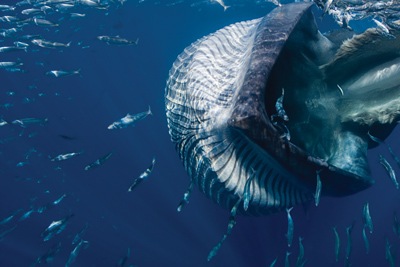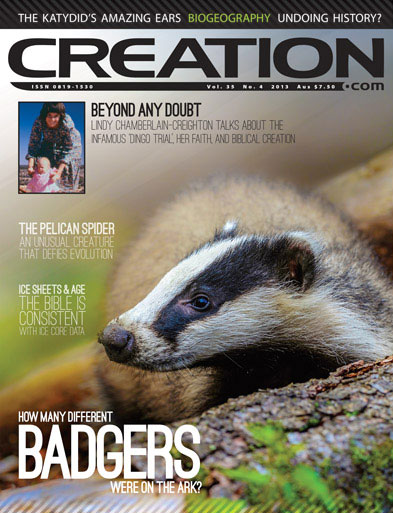Baleen whales have unique sensory organ

Some of the largest animals ever to exist on the earth are the baleen whales, including the largest of all, the blue whale, about 30 metres (100 ft) long and weighing about 200 tonnes. They are very different from the toothed whales that evolutionists claim they evolved from. Instead of attacking large prey, they gulp enormous amounts of water into their mouths—up to 80 m3 (almost 3,000 cubic feet). This is expelled through comb-like bristly plates of baleen, often called “whalebone” although it is made of keratin, just like hair and skin. Shrimp-like animals called krill, as well as small fish, are caught and swept up by the tongue then swallowed as food, only about 10 kg per gulp.
The largest group of baleen whales, including the blue, are rorquals (Balaenopteridae), which have pleated folds of skin running lengthwise along the lower jaw. These enable the mouth to expand enormously. Also, the right and left halves of the lower jaw bone are not fused, so can expand sideways.
Both these features are important for the rorquals’ unique mode of attack called “lunge-feeding”, swimming very fast to build up the necessary pressure. Lunge-feeding “involves rotating the jaws, inverting the tongue and expanding the throat pleats and blubber layer,” according to Nick Pyenson of the Smithsonian.1 Lunge-feeding has been called the largest biomechanical event on earth.2
Now Dr Pyenson and his team performed a CAT scan of a whale jaw. They found a unique grapefruit-sized organ, rich in nerve and blood supply, within the fibrous cartilage tissue that connects the left and right lower jaw tips.3 Pyenson says, “We think this sensory organ sends information to the brain in order to coordinate the complex mechanism of lunge-feeding”.1 The organ detects “dynamic rotation of the jaws during mouth opening and closure,”3 and “provides the necessary input to the brain for coordinating the initiation, modulation and end stages of engulfment.”3 It also “probably helps rorquals feel prey density when initiating a lunge”.1 That is, this particular organ seems essential so that the enormous energies involved don’t damage their unfused jaws.
Common sense would suggest that this is a design feature. However, the researchers pay the obligatory fact-free homage to evolution. Without giving any step-by-step mechanism, the researchers assert that this organ evolved before large size and other rorqual features did. Indeed, it was asserted to be a ‘pre-adaptation’ that is “responsible for rorquals claiming the largest-animals-on-earth status”, according to Pyenson’s co-author Bob Shadwick of the University of British Columbia. Yet it is only the large size, producing the huge energies of this “extreme feeding method”, that would necessitate such a complex organ in the first place. The ‘pre-adaptation’ claim is a tacit admission that they can’t explain what selective forces could have produced the organ.
References and notes
- Rorqual whales have unique new sensory organ, wildmammal.com, 30 May 2012. Return to text.
- Potvin, J. and Goldbogen, J.A. Passive versus active engulfment: verdict from trajectory simulations of lunge-feeding fin whales Balaenoptera physalus, Journal of the Royal Society Interface 6(40):1005–1025 | doi:10.1098/rsif.2008.0492. Return to text.
- Pyenson, N.D. et al., Discovery of a sensory organ that coordinates lunge feeding in rorqual whales, Nature 485 (7399):498–501, 2012 | doi:10.1038/nature11135. Return to text.



Readers’ comments
Comments are automatically closed 14 days after publication.